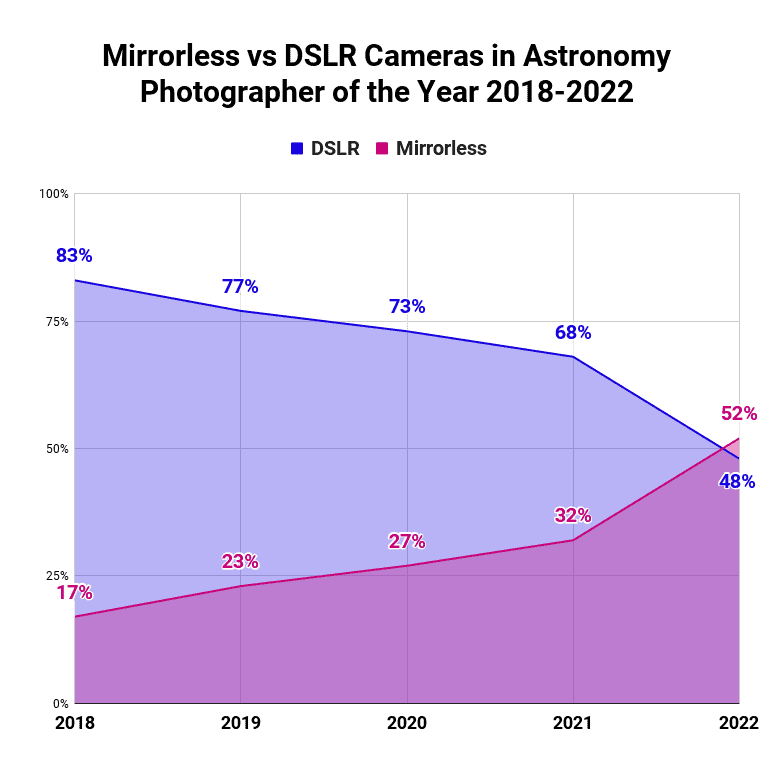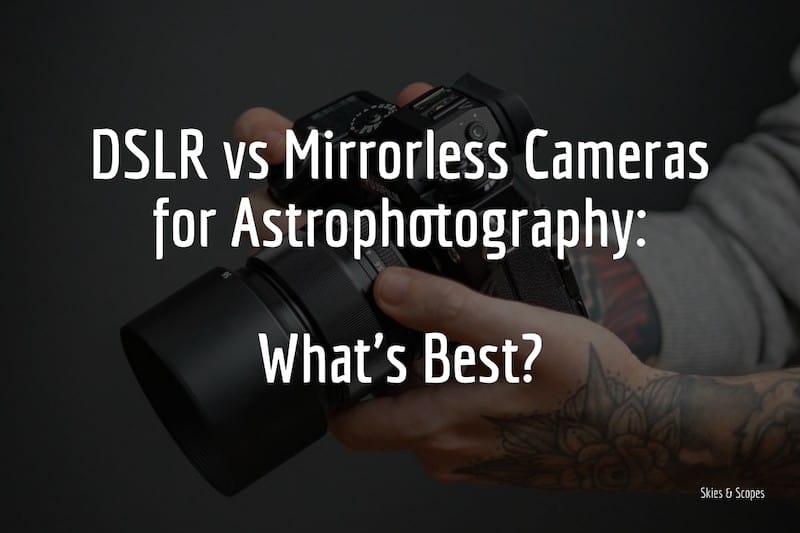We looked at hundreds of photos shortlisted for the world’s leading astrophotography competition in the last three years to see how many were shot with DSLR vs mirrorless cameras.
We found that 2022 was the year that mirrorless cameras became more commonly used that DSLRs:

But does that mean mirrorless cameras are better than DSLRs for astrophotography?
In short, no!
There are a few pros and cons of each, but whether your camera is DSLR or mirrorless it is unlikely to be a significant factor in whether or not you can take good astrophotography images.
Read on for the full analysis and to understand more about DSLR vs mirrorless for astrophotography.
DSLR vs Mirrorless Cameras for Astrophotography (Data Analysis)
We tried to find the Best Cameras for Astrophotography by looking at five years of images shortlisted in the Astronomy Photographer of the Year competition.
There were 685 images shortlisted from 2018 to 2022. Of these, 355 were taken with mirrorless or DSLR cameras.
Overall, when comparing DSLR vs mirrorless cameras for this five-year period, DSLRs have been more frequently used with a split of 71% DSLR to 29% mirrorless.
However, as you can see in the chart above, when we break down the data year by year we see that the proportion of shortlisted images taken with mirrorless cameras increases each year:
- 2018: 17%
- 2019: 23%
- 2020: 27%
- 2021: 32%
- 2022: 52%
So, although historically DSLRs are more likely to have been used by astrophotographers, there is an upward trend in the use of mirrorless cameras.
This reflects the general market trend moving towards mirrorless.
DSLR vs Mirrorless Explained
Let’s look now at the major differences between DSLR and mirrorless cameras and see if there are any factors that may give one or the other any advantages for astrophotography.
Differences Between DSLR and Mirrorless Cameras
The essence of the difference between DSLR and mirrorless cameras lies in the internal structure:
- DSLRs include a mirror that reflects the light captured through the lens into the viewfinder that you look through to compose the image. When you press the shutter, the mirror flips up and the light goes straight to the sensor and creates a photo.
- Mirrorless cameras – you guessed it – have no mirror. The light goes straight from the lens to the sensor with no need to move this internal component when taking a photo. The viewfinder then is electronic and displays the image directly from the sensor.
This video is fairly old now, but it gives a good quick overview of the main differences between mirrorless and DSLR cameras:
DSLR Camera Advantages
The main advantages of DSLRs cameras are:
- Price: Although the cost of mirrorless cameras has come significantly down in the past ten years or so they do still tend to cost a little more than DSLRs on a like-for-like basis. For example, you can generally get a full frame DSLR for cheaper than a full frame mirrorless. In addition, because DSLRs have been around for longer (and because people are moving away from them) there is much more availability of perfectly good used models on the second-hand market.
- Experience: DSLRs are tried and trusted by photographers and have been for decades.
- Lenses: Because of the relative immaturity of the mirrorless markets, there are more lens options available for DSLRs than there are for mirrorless cameras.
- Battery life: Tests indicate that in general DSLRs have better battery life than mirrorless cameras. This should at least be in part due to not needing to power the electronic viewfinder.
- Viewfinder: Some photographers prefer seeing the real thing through a DSLR viewfinder, rather than an electronic simulation as you do with a mirrorless. However, for astrophotography, an electronic viewfinder (or screen) is very useful as you get a better idea of what your photo will look like with your chosen settings. It is also one of the easiest ways to focus and make sure the stars are pinpoint sharp before taking your photo (note that many top DSLRs do also have electronic viewfinder screens).
Mirrorless Camera Advantages
The main advantages of mirrorless cameras are:
- Size: Mirrorless cameras are smaller in terms of bulk than DSLRs, at least in part because they don’t have a movable mirror inside.
- Weight: Mirrorless cameras are lighter than DSLRs (see the chart below). This is significant for astrophotographers since you want to reduce the payload burden on your star tracker or telescope mount if you are using one to have smoother tracking. In addition, you may well be going out into the field to take photos and reducing the weight you carry is always going to be a positive.
- Lenses: The lenses made specifically for mirrorless cameras also tend to be smaller and lighter. This is particularly the case for some great wide-angle, prime lenses that are perfect for landscape astrophotography. To some degree mirrorless cameras also have greater compatibility with more lenses since the mounts on DSLRs can be more restrictive in terms of what lenses you can attach.
- Vibration: DSLR cameras have a “mirror slap” when taking an image. This is when the mirror moves out of the way to take a shot. This is a potential disadvantage for astrophotography since this movement creates a small amount of vibration and you are going to be taking long exposures that require your camera to stay completely still. Since mirrorless cameras have no mirror, they also have no mirror “slap”.
- Future-proofing: The mirrorless market is fast-growing and most major manufacturers are putting their resources into developing new mirrorless cameras and lenses. As it has done in the past decade, this will likely result in competitive technological development improving mirrorless cameras and bringing the price down and improving the range of compatible lenses and other accessories.
- Live View: The Live View image is much brighter in mirrorless cameras when shooting at night. This means that you can see more of the night sky before taking (and processing) the image and so can really help with framing the shot and visualizing what you will end up with.
Mirrorless vs DSLR Weight
You can see in this table a quick comparison of the weights of the top DSLR and mirrorless cameras for astrophotography:
| Camera | DSLR/Mirrorless | Weight (Body) |
|---|---|---|
| Canon EOS 6D | DSLR | 1.7 lbs |
| Canon EOS 5D Mark IV | DSLR | 2.02 lbs |
| Nikon D750 | DSLR | 1.65 lbs |
| Nikon D850 | DSLR | 2.02 lbs |
| Sony A7R III | Mirrorless | 1 lb |
| Sony A7 III | Mirrorless | 1.44 lbs |
As you can see, the Sony mirrorless models weigh less than the top DSLRs.
In some cases (e.g. Sony A7R III vs Canon EOS 5D Mark IV) this is as much as 50% less.
FAQs: DSLR vs Mirrorless Cameras for Astrophotography
Are mirrorless cameras better than DSLRs for astrophotography?
Neither mirrorless cameras or DSLR cameras are inherently better for astrophotography. Both have their own pros and cons as camera types and both can be used to take excellent astrophotography images.
Can you do astrophotography with mirrorless?
You can have great success in astrophotography using interchangeable lens mirrorless cameras, as demonstrated in our research.
Do I need a mirrorless camera for astrophotography?
You do not need a mirrorless camera for astrophotography but you can use one or a DSLR camera for this.
Should I switch from DSLR to mirrorless?
The main reason to switch from DSLR to mirrorless is weight. If you were seeking a lighter camera and want to pair it with a lighter lens, then mirrorless might make sense for you.
Which mirrorless camera is good for astrophotography?
Our analysis shows that the Sony A7R III and the Sony A7 III have been used to great success for astrophotography.
See the Best Mirrorless Cameras for Astrophotography.
What kind of camera is best for astrophotography?
The best cameras for astrophotography are DSLR or mirrorless cameras that allow interchangeable lenses and have full frame sensors of at least 20 megapixels.
See the Best Cameras for Astrophotography, as well as Full Frame vs APS-C: What’s Best for Astrophotography?.
Do megapixels matter for astrophotography?
You need enough megapixels to be able to image in sufficient detail, but having too many megapixels can actually degrade the image quality. High MP can also have other drawbacks relating to having to deal with much larger files when post-processing on your computer.
See How Many Megapixels Do You Need for Astrophotography?.
How do you shoot a Milky Way with a mirrorless camera?
Shooting the Milky Way involves a lot of planning as it is only visible for certain months of the year and will be in the right position for a certain time on any night. Add to this that you need skies clear of clouds and no moon (or other light pollution), as well as a good location to shoot from in the middle of the night.
Once you have planned this you need to use manual mode to take a long exposure shot of the night sky at a fast aperture to ensure you capture enough of the faint light coming from the stars.
For more detailed steps, see How to Photograph the Milky Way.
Do I need to modify my DSLR for astrophotography?
You don’t need to, but doing so can improve the colors your camera can pick up in images from deep sky objects.
See our article on Astro Modified Cameras.
Is Nikon or Canon better for astrophotography?
Both Nikon and Canon make great cameras that work excellently for astrophotography.
See Canon vs Nikon vs Sony Astrophotography: What’s Best?.
What does DSLR mean?
DSLR stands for Digital Single Lens Reflex.
What are mirrorless cameras?
Mirrorless cameras are defined by the absence of the mirror that sits inside DSLR cameras.
With DSLRs, the mirror reflects light to the viewfinder that you look through when composing the shot and moves out of the way when you press the shutter button. Mirrorless cameras do not have this and instead show the image from the sensor into an electronic viewfinder. This makes them smaller and lighter.
Conclusion
Overall, it is not the case that DSLRs are better than mirrorless cameras for astrophotography, or the other way around.
Both can be used to take exceptional astrophotography images in the right hands and with the right accompanying gear.
When looking at our astrophotography competition data, we see that DSLRs have been more frequently used but this most likely reflects the higher instance of ownership in past years as much as anything. After all, most people do not just buy brand new cameras for thousands of dollars every year, especially if they already have a good DSLR that they know how to get the best from.
We can see from the data that mirrorless cameras for astrophotography are becoming more common and this is likely to continue in the future as this is where the major manufacturers are putting their focus on with new models of mirrorless cameras and compatible lenses coming out.
So if DSLR vs mirrorless is not a factor for astrophotography, what should you look for?
In terms of what you do need from a camera for astrophotography, we recommend that having a full frame sensor is best (especially for landscape astrophotography) and that a megapixel count of around 20MP to 30MP is perfect.
If you are after recommended models, head over to the Best Cameras for Astrophotography.



